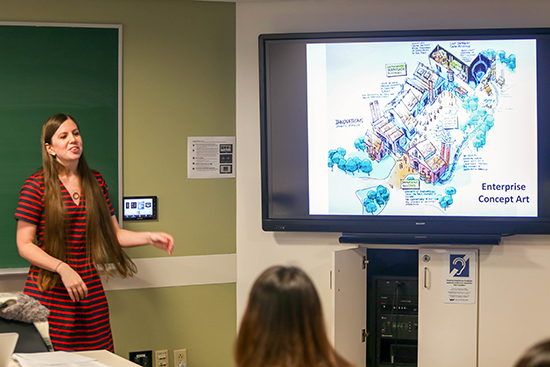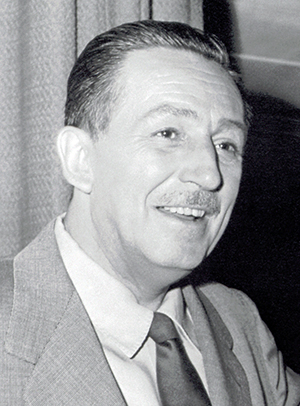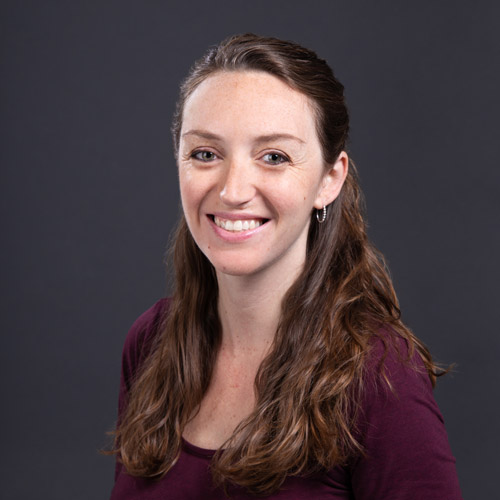Exploring the Wonderful World of Disney
New writing class a hit with students

Tessa Croker (GRS’16), a College of Arts & Sciences Writing Program lecturer, says enrollment for the Wonderful World of Disney course filled up so quickly that she could have filled two sections. Photo by Chenyao Xu (COM’17)
Class by class, lecture by lecture, question asked by question answered, an education is built. This is one of a series of articles about visits to one class, on one day, in search of those building blocks at BU.
No corporate brand has done a better job of infiltrating American lives than Disney. The Walt Disney Company’s film studio, consumer products, and parks and resorts have had an outsized role in shaping the imagination of generations of children. Films like Frozen and Inside Out earn hundreds of millions at the box office and spawn costumes, action figures, and plush toys. The 11 Disney parks around the world draw more than 130 million visitors annually, and last year’s reported $48.8 billion in revenue was the highest in its 92-year history.
The company is the subject of a new writing course, WR150: The Wonderful World of Disney, that examines the ways the Disney corporation—including entertainment, theme parks, and even founder Walt Disney’s role in modern city planning—have influenced America’s culture and society. Among assignments are watching classic Disney films like The Little Mermaid and Aladdin, reading essays critiquing the racial representation in the studio’s films, and discussions about Disney theme parks. Before the semester is finished, students must write three papers: one on why Disneyland was successful in the context of the Cold War, another on whether Disney princess movies made during the 1990s should be seen as feminist or antifeminist, and a third on a research topic of their choosing.
Tessa Croker (GRS’16), a College of Arts & Sciences Writing Program lecturer, came up with the idea for the class. She says enrollment filled up so quickly that she could have easily filled two sections.
She has been pleased and surprised by her students’ enthusiasm for the class and their support of all things Disney, ironic since she is currently writing her dissertation on Disney fan culture. “This class is a great opportunity to get students thinking about what they may see as their everyday world around them in new ways,” she says. “It’s fun having a subject that they are personally engaged in and they think about their place within it.” Many in the class are ESL students and she says it’s interesting for her to see what the Disney brand has taught them about American culture.
On a recent Friday morning, class discussion centers on Disney’s 11 theme parks (a 12th is scheduled to open next spring in Shanghai). Croker first asks how many students have visited a Disney theme park, and every hand shoots up.

She next introduces a commercial for Dismaland Bemusement Park, an art exhibition by anonymous graffiti artist Banksy that pokes fun at much about Disney. Croker asks the students to be on the lookout for the specific things Banksy is satirizing. View the clip here.
“What kinds of things are being criticized?” Croker asks the class.
The price of the park, for one, a student answers. In Banksy’s video, there’s a booth for pocket change loans; at the actual Magic Kingdom in Orlando, Fla., one-day tickets can run more than $100. In one display, Cinderella’s pumpkin carriage, with her inside, has crashed and lies on its side, calling to mind the accident that killed Princess Diana.
“We can see from this that Disney and its theme parks are still very much open for criticism even as they celebrate their 60th year in Disneyland,” Croker says. “And as much as Banksy is criticizing Disney, he’s also criticizing world culture, the idea that you are bored, and therefore you have to go somewhere to be entertained.”
Being able to examine popular culture through just one company helps to explain the class’ appeal: “Disney becomes a vehicle through which you can criticize modern society,” Croker says. “Disney is in the public eye, the beacon around which some of these debates sort of center.”
The students next hear a bit of Disney history. They learn that Walt got the idea for his first theme park after visiting carnivals with his young daughter and being disgusted by what he saw. He envisioned a theme park that would be much cleaner and more wholesome. Today, Croker notes, the parks don’t even sell gum, part of an effort to keep the sidewalks clean.
“The concept of a theme park is entirely Disney’s creation,” she says. “This idea where you step in the doors and you’re in an entirely imaginary world is something very new and something he created.” Walt became so passionate about the world that he wanted for his theme parks that he initially envisioned one of them, EPCOT (Experimental Prototype Community of Tomorrow), to be a working city.
“People were very concerned that Disney might be doing city planning,” says Croker, because his communities would lack authenticity and be separated from reality. By way of example, she points to Disney’s Animal Kingdom park, where the huge tree that welcomes guests as they walk in the gates is made of fiberglass and has vinyl leaves. Another such example: the Caribbean island Castaway Cay, owned by the company and used exclusively by its cruise ship guests. Seaweed on the beach is promptly removed and Mickey statues are placed underwater for snorkelers to “find.”
“During previous classes we talked about how people might just want a break from reality, which is OK, but scholars are increasingly concerned with what messages this gives in the long term,” Croker tells her students.
The class won’t be offered next semester (Croker, a doctoral student in BU’s American & New England Studies program, is taking a break from teaching to finish her dissertation), but it will likely be offered again next fall because of its popularity.
While the Disney name was the initial draw for most students, they say the class has taught them more than they were expecting. “I chose this section of WR150 because I have a big fascination with fairy tales, especially Disney’s animated version of fairy tales,” says Thanh Nguyen (ENG’18). “But the thing that’s been most interesting to learn is how Disney has a strange way of doing things under cover and how much security they use in their parks. It’s been really thought-provoking.”
This Series
Also in
One Class, One Day
-
November 30, 2018
Breaking Bad Director Gives CAS Class the Inside Dope
-
October 31, 2018
Trump and the Press: We’ve Been Here Before
-
August 3, 2018
A Scholarly Take on Superheroes


Comments & Discussion
Boston University moderates comments to facilitate an informed, substantive, civil conversation. Abusive, profane, self-promotional, misleading, incoherent or off-topic comments will be rejected. Moderators are staffed during regular business hours (EST) and can only accept comments written in English. Statistics or facts must include a citation or a link to the citation.